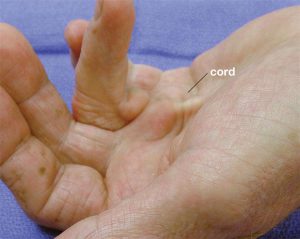Dupuytren’s Contracture
Dupuytren’s disease is characterized by abnormal thickening of the fascia—the tissue just beneath the skin—in the palm. This thickening can extend into the fingers, forming firm pits, nodules, and cords. When these cords cause the fingers to bend toward the palm, the condition is known as Dupuytren contracture. Although the skin may be affected, deeper structures such as tendons remain uninvolved. In some cases, thickening may also appear on the finger knuckles (knuckle pads) or on the soles of the feet (plantar fibromatosis).
CAUSES
The exact cause of Dupuytren’s disease remains unknown; however, certain biochemical factors in the fascia may be involved. The condition is more prevalent in men over age 40 and in individuals of northern European descent. There is no conclusive evidence linking hand injuries or specific occupational exposures to a higher risk of developing the disease.
SIGNS AND SYMPTOMS
Dupuytren’s disease typically presents with lumps and pits in the palm, which are firm and adherent to the skin. Thick cords may develop beneath the skin, extending from the palm into one or more fingers—most commonly affecting the ring and little fingers. These cords, which lie between the skin and tendons, can lead to finger contractures. Often, both hands are affected, though the severity may vary. Initial nodules might cause temporary discomfort, but the disease is generally not painful. It is often first noticed when the patient finds it difficult to place the hand flat on a surface. As the fingers draw into the palm, activities such as washing, wearing gloves, shaking hands, or putting hands in pockets become increasingly challenging. The progression is unpredictable, with some individuals experiencing only minor lumps while others develop severe finger bending, often at an earlier age.
TREATMENT
In mild cases where hand function is not compromised, observation alone may be sufficient. For more severe cases, several treatment options exist to straighten the affected fingers:
- Collagenase Injection: A small amount of medication is injected into the diseased tissue to weaken it, allowing manual manipulation to straighten the finger.
- Needle Aponeurotomy: A needle is used to sever the Dupuytren tissue through the skin, an office procedure that can help relieve contractures.
- Open Surgery: In more complex cases, surgery may be needed. Specific considerations include:
- The presence of a lump in the palm does not necessarily require surgery or predict disease progression.
- Correction is most effective with milder contractures or those affecting the base of the finger; complete correction of severe contractures, particularly at the middle and end joints, may be challenging.
- Skin grafts might be necessary if there is a skin deficiency.
- The nerves supplying sensation to the fingertips are often intertwined with the cords.
- Postoperative splinting and hand therapy are commonly recommended to maximize and maintain improvements in finger position and function.
Key Takeaways


